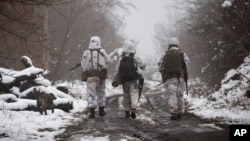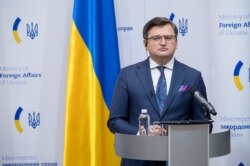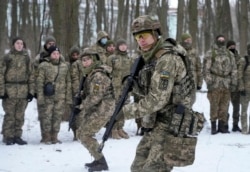Russia doesn’t have enough troops in place to mount a “full-scale invasion,” according to Ukraine’s foreign minister.
Dmytro Kuleba told reporters, “The number of Russian troops massed along the border of Ukraine and occupied territories of Ukraine is large, it poses a threat to Ukraine, a direct threat to Ukraine; however, at the moment, as we speak, this number is insufficient for a full-scale offensive against Ukraine along the entire Ukrainian border.”
Russia has denied it is preparing to launch a major assault, but U.S. President Joe Biden and his aides say Moscow could “attack at very short notice” with the more than 100,000 troops it has deployed along Ukraine’s borders.
Kuleba’s statement came just hours after Ukraine’s President, Volodymyr Zelenskiy, urged Ukrainians during a nationwide broadcast to remain calm, but have no “childish illusions” about the magnitude of the Russian threat. “Protect your body from viruses, your brain from lies, your heart from panic,” he urged.
The Ukrainian leader took issue with this week's evacuation by the United States, Britain, Canada and Australia of some personnel from their embassies, telling Ukrainians the evacuation doesn't mean escalation is inevitable. Ukrainian officials expressed frustration earlier this week with the departure of some Western diplomats and their families, saying it was premature.
One official told VOA the evacuations undermined efforts to calm the fears of ordinary Ukrainians. The United States and Britain also have told their nationals to leave. “Given that the president has said military action by Russia could come at any time, the U.S. government will not be in a position to evacuate U.S. citizens,” a State Department spokesperson said earlier this week.
According to Ukrainian officials, Zelenskiy broached the issue of evacuations during U.S. Secretary of State Antony Blinken's visit to Kyiv last week, saying to withdraw staff now would be an “overreaction” and send an inconsistent message to Russia, as well as prompt alarm — something Moscow could exploit.
Ukrainians have lived with Russian threats for nearly eight years, since the Maidan uprising of 2014, which toppled President Viktor Yanukovych, an ally of Russian President Vladimir Putin. In the Donbas region of eastern Ukraine, which pro-Moscow armed proxies seized after the Maidan revolt, fighting has flared and simmered, leaving more than 15,000 dead.
But with more than 100,000 Russian troops camped along their borders and threatening the biggest land war in Europe since the Second World War, ordinary Ukrainians are on edge. Many are formulating contingency and flight plans in case of an invasion, including stockpiling essential staples and preparing their belongings if they have to flee.
Ukrainians have been swapping tips on social media platforms about preparing for war, including on Facebook under the hashtag #миготові (#weareready). “Every family wants to learn how to prepare for an emergency and do whatever is necessary in advance,” posted Valeriy Pekar, an academic.
How to manage anxiety is a political issue, he says. “Pretending that nothing is happening — it means that when something happens, panic will be unacceptably high. If you push it now — the panic will be unacceptably high right now. I see the only possible strategy: to raise anxiety level gradually so that people can think, get used to it, start doing something little by little,” he says.
Ukraine's Ministry of Culture and Information Policy has issued an Emergency of War Brochure with tips on what preparations families should be making and how to react if war does break out. In Kyiv, though, there are few obvious signs of alarm, and banks are not reporting any heavy cash withdrawals.
Ukraine’s former defense minister, Andriy Zagorodnyuk, also has sounded a note of reassurance, saying in a newspaper article Monday the Kremlin has not yet amassed enough troops to launch a large-scale operation.
Zagorodnyuk says Russia would need a force of several hundred thousand to stage an invasion. Among the elements missing, he indicates, are mobile field hospitals, noting that several battalion tactical groups do not have their full complement of tanks and armored vehicles. “If Russia was conducting preparations for a large-scale invasion, it would have been much more noticeable,” Zagorodnyuk said.
Meanwhile, Britain’s foreign secretary, Liz Truss, has called on NATO allies to "do more” to pressure Russia and support Ukraine. Speaking Wednesday to the BBC, Truss called for more efforts to deter Russia and make clear the price of war will be high. “We would like to see our allies do more to help supply defensive support to Ukraine,” she said.
Truss added the British government is drafting new legislation to bolster Britain's sanctions regime “so we are able to target more companies and individuals in Russia.”











